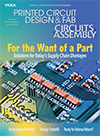ROI
 The industry’s next generation is on the rise.
The industry’s next generation is on the rise.
I am continually amazed at how many people I see and run into at each industry meeting or event – especially at technical meetings when I’m watching people leave one room and enter another for the next session. It strikes me a bit like watching the changing of the guard at Buckingham Palace – people leave one room to enter the next to do the same thing, and repeat!
One thing that makes our industry so strong and enduring is having so many people work together to contribute to developing and refining technologies, writing standards for those technologies and processes, and sharing their knowledge with others to fully understand those technologies and standards. And then as they say, “repeat.”
Exclusively staying ahead or behind the technological curve can lead to misfortune.

Over the past decades, it has been my experience that there are two basic categories of technology: "cutting-edge" and "behind the curve." Electric (rechargeable) automobiles, for instance, would be considered cutting-edge while hybrid (gasoline and battery) automobiles are behind the curve.
Interestingly, when it comes to technology adoption, there also seem to be two types of users. There are those who must be ahead of the curve, always first with the latest technology regardless of how well it may work or how much it costs. And there are those who use only proven technology that is reliable, cost-effective and offers value.
Back in 2013, a friend took delivery of an early Tesla Model S. He was so excited to finally have an electric car, and it sure was a beauty. I remember asking him how it drove. "Like nothing else I have ever driven," he responded. But when I asked how far it could go between charges, he replied "I do not know."
Look past the scary headlines and stay focused on business plan fundamentals.

Welcome to 2023. As ready as we all try to be when beginning the annual cycle of booking orders, scheduling resources, shipping product, and oh yes, collecting payment, this year many are still tweaking their annual budgets. The effects of rising inflation and a prolonged unstable supply chain are causing many to rethink how they must operate their business to maintain margin and profitability.
Widespread critical staffing needs call for a cross-industry effort to promote manufacturing.

With this time of year come many opportunities to attend industry gatherings, catch up with industry colleagues, and find out what’s happening in the macro circuit board supply chain. Over the past couple months, I have seen many old friends. And, I have had more than a few opportunities to reflect on our industry, the state of the supply chain, and what is “critical” versus just “important.”

Additive manufacturing might not be ready for prime time, but it’s making inroads.
Sometimes I find myself walking around the shop floor asking, “Why do we have all this very expensive equipment? There must be a simpler, cheaper way to make a printed circuit board!” And yet, despite phenomenal technological strides, our industry still uses the same basic manufacturing processes since the earliest days of circuit board production: drill – image – plate – press – repeat – then route.
Observing so many different processes, simple logic might make you think printing conductive ink would have replaced plating processes long ago. Yet while printed electronics has advanced considerably, it is not ready for prime time for all applications.

A sense of urgency most go toward protecting your tribal knowledge.
Every business keeps a mindful eye on critical assets. On any corporate balance sheet those assets are identified, valued and periodically updated. Indeed, business valuations are often tied directly to those assets, enabling companies to borrow money to acquire additional assets. Regrettably, no balance sheet includes or values the most important and valuable (and perhaps invaluable) asset a company has: tribal knowledge.
The term “tribal knowledge” is used to encompass all the knowledge, experience and wisdom a business’s combined workforce brings to the game each day. It describes what for centuries has been a key asset of all businesses, especially manufacturers. Despite its importance however, historically it has not been universally acknowledged of value nor viewed as a competitive advantage that contributes to organizational profitability.


